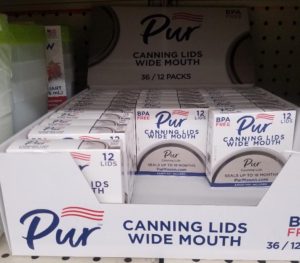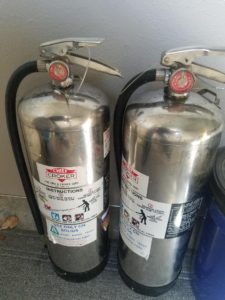I have all the things necessary for home canning, and I do occasionally engage in the practice. I don’t do it often because I don’t really have much need to…after all, I can always buy commercially canned vegetables and meats at pretty much any grocery. However, just because I can do something today doesn’t mean I’ll be able to do it tomorrow. Also, sometimes I cook stuff that I rather like (bunker gumbo ) and like to have some of it sitting on the shelf for a quick meal. And, of course, when the wheels really fly off civilization and the electricity becomes a pleasant memory, I’ll have a whole freezerfull of meat that needs to suddenly be repackaged in a shelf stable manner. Canning lets me do that. And, if you’re the type with a big garden and good hunting skills, canning lets you put a lot of food away at very reasonable prices.
Anyway, I was in the local independent supermarket getting my lunch at work the other day and as I walked by the aisle where they keep the home canning stuff I saw these:

A couple cases of wide-mouth lids. And not that cheap Chinese-made crap that has been showing up on the market:


Seriously…if you’re willing to purchase this crap because it’s $2 cheaper than Ball or Kerr, you deserve the problems that are going to come from these things. From what I’ve read they don’t seal well, don’t hold seal well, are spotty in the application of adhesive, and tend to buckle. Sure, their availability may be better than Ball or Kerr, but if you have to throw away the food, or make three attempts to get a good seal, or worst of all, go into your pantry six months from now and find a jar of what looks like vomit, was it really worth the ‘savings’?
Being a good survivalist, I spoke to a few LMI and asked if they needed any lids. Why not? If the world is going to sink into another World War or Great Depression then I want those people to have every advantage possible. Short version: I want a world with more of them and less of everyone else. Brutal, but true.
One person mentioned that they hadn’t ‘gotten into’ canning yet. Picked a hell of a time to start, I told him. He said he was waiting for a course at the continuing education facility to be offered. Dude, it ain’t rocket science and time may 9or may not) be of the essence. So, for those of you who haven’t experienced the joy of filling your kitchen with heat and steam, here’s youre shopping list:
Information…don’t start a trip without a map. There are plenty of good books on the subject, the one I use and recommend is:
Read it, read it again, and then flip through it another time. Nothing magical about canning…anyone can do it. But spoiled food is dangerous ‘food’ and you really want to pay attention to what you’re doing,. It’s no different than reloading ammo in that regard…it isn’t difficult, but you do want to pay attention.
I like the pressure canning, which is necessary to can meat or any food that contains meat (sauces, stews, etc.). This is gonna be the most expensive part of the process. Just resign yourself to spending the money and know that this thing will literally last you the rest of your life. It doesn’t use a gasket so if you’re concerned about replacement part availability, this is a great choice. I use this particular model:
Yes, not cheap. But I’ve had mine for a long time and haven’t had a lick of trouble from it. This particular package comes with tools that you’ll want….lid lifter, jar lifter, spatula, food funnel, etc. One-stop shopping. But this baby will let you can everything and in large quantities. Its big and heavy, so no glasstop ranges for this monster.
After that, its time for lids, jars, and bands. Most any hardware store (during normal times) will have them. You can’t have too many. Jars are reusable as long as they aren’t chipped at the mouth. Bands are reusable. Lids are not. Yes, some people reuse them. I don’t. Food poisoning is not worth trying to save $1 by reusing a lid or two. I don’t have the time to investigate every brand out there so I usually just stick to Ball as my first choice and then Kerr. Lots of people ‘inherit’ jars from grandma or some great aunt’s estate…thats fine but inspect them thoroughly for chips or damage.
All this stuff will fit in a large plastic tote that can sit on your basement shelving when you’re not using the canner. Find a great deal on meat? Can it. Neighbors had a bumper crop of tomatoes or something? Can ’em. Made a huge batch of vegetable beef soup and want the convenience of just heat-n-eat out of a jar? Fire up the canner.
As I said, I don’t do much gardening these days but I do hunt for bargains on meat. And when I do find a deal on meat canning it saves me freezer space, is convenient, and allows me to store a good bit of animal protein against whatever is coming. And if nothing happens? Well, it’ll still taste just fine and I’ll have saved a buncha cash.


